
The Yakovlev Yak-24 is a Soviet twin-engine, tandem rotor, transport helicopter developed by Yakovlev in the 1950s. The Yak-24 saw limited use in the Soviet Air Force, and the exact number produced and duration of service are unknown due to inconsistencies in data.

The Mil Mi-1 was a Soviet three- or four-seat light utility helicopter. It was the first Soviet helicopter to enter serial production. It is powered by one 575 hp Ivchenko AI-26V radial. It entered service in 1950 and was first seen on the 1951 Soviet Aviation Day, Tushino and was produced for 16 years. More than 1,000 were built in the USSR and 1,594 in Poland, as SM-1.

The Kamov Ka-18 was a Soviet four-seat utility helicopter that first flew in 1955. It was a development of the Kamov Ka-15, with a lengthened fuselage and a more powerful engine - the 255 hp Ivchenko AI-14V radial. Total production from Kamov was about 120 units.

The Kamov Ka-10 was a Soviet single-seat observation helicopter that first flew in 1949.
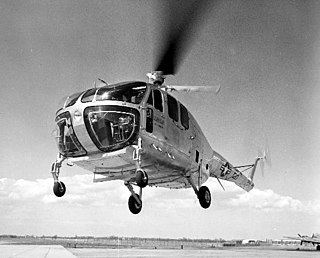
The Bell R-12 was an American 1940s military utility helicopter built by the Bell Helicopter company.

The Bratukhin Omega was an early Soviet helicopter, the first product of a new Soviet design bureau, OKB-3 that was created from within TsAGI specifically to develop rotary-wing aircraft. Bratukhin's design was a side-by-side twin rotor machine, with each rotor carried on a long outrigger truss. The Omega's rotors were each powered by a separate engine carried in a nacelle also at the end of the truss. Captive trials commenced in August 1941 and revealed severe problems with engine vibration and overheating. Before these could be addressed, however, OKB-3 was evacuated ahead of the German advance into the Soviet Union.
Bratukhin, or OKB-3, was a Soviet aircraft design bureau created in 1940 from within TsAGI to develop helicopters. Headed by Ivan Pavlovich Bratukhin, the bureau built several experimental helicopters over the next decade. Each model had the same basic design of two rotors with separate engines carried on the ends of outriggers to each side of the fuselage. The bureau was dissolved in 1951.

The Firestone XR-9, also known by the company designation Model 45, was a 1940s American experimental helicopter built by the Firestone Aircraft Company for the United States Army Air Forces. Only two were built.
The Landgraf H-2 was an American single-seat twin-rotor helicopter designed by Fred Landgraf and built by the Landgraf Helicopter Company of Los Angeles, California. Although awarded a development contract by the United States Army it was not developed and was overtaken by more advanced designs.
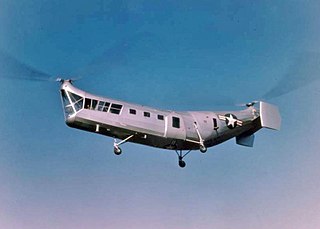
The Piasecki HRP Rescuer is a United States tandem-rotor transport or rescue helicopter designed by Frank Piasecki and built by Piasecki Helicopter. The Piasecki PV-3 was adopted as the HRP-1 Rescuer by the United States Navy, United States Marine Corps, and United States Coast Guard. An improved PV-17 variant was later produced as the HRP-2. As one of the first transport helicopters in military service, the HRP-1 was capable of carrying two crewmen and 8-10 passengers or 2,000 lb. (907 kg) of cargo.
The Yakovlev EG, also commonly known as the Yak-M11FR-1 and Sh (Shootka), was an experimental aircraft with coaxial rotors. The prototype was first flown by V.V. Tezavrovsky in December 1947.
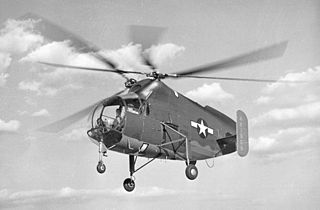
The Kellett XR-8 was a helicopter built in the United States during World War II. It was a two-seat machine intended to demonstrate the feasibility of a twin-rotor system, and while it accomplished this, it also demonstrated a number of problems that prevented further development of this particular design.
The Yakovlev Yak-20 was an experimental piston-engined trainer developed in the Soviet Union in 1949. It did not go into production.

The Yakovlev Yak-100 was a single-engine, transport helicopter developed in the USSR in 1948. This was the Yakovlev Design Bureau's second helicopter.

The Piasecki H-16 Transporter was a tandem-rotor transport or rescue helicopter designed by Frank Piasecki and built by Piasecki Helicopter. The prototypes were evaluated by the United States Air Force and Army, but the crash of the second test aircraft led to cancelling the project.
The Beriev MDR-5 (sometimes Beriev MS-5) was a Soviet long-range reconnaissance/bomber flying boat developed by the Beriev design bureau at Taganrog. It did not enter production as the rival Chyetverikov MDR-6 was preferred.
The Bratukhin B-5 was a prototype Soviet twin-rotor transport helicopter designed by the Bratukhin aircraft design bureau.
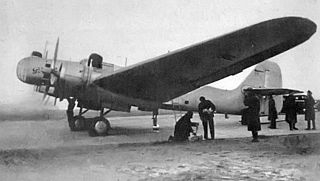
The Tupolev ANT-37 was a Soviet twin-engined long-range bomber designed and built by the Tupolev design bureau, the design team operating under the guidance of Pavel Sukhoi. The aircraft did not enter production, but three examples of the type were used for research and record breaking flights.
The Yatsenko I-28 was a 1930s Soviet single-seat fighter designed by Vladmir Yatsenko and first flown in 1939. The I-28 was a low-wing cantilever monoplane of mixed construction powered by a 900 hp (671 kW) Tumansky M-87 radial piston engine. It had an enclosed single-seat cockpit with a rearwards sliding canopy. The wing had an inverted-gull shape to reduce the length of the retractable main landing legs. The prototype was destroyed shortly after the first flight but an order was placed for 30 production aircraft. Also ordered was a prototype of an attack version, the I-28Sh. Although the first five production aircraft were completed the programme was cancelled in early 1940.
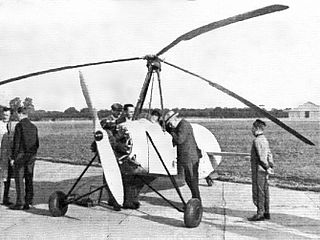
The Hafner A.R.III Gyroplane was a British 1930s experimental autogyro designed by Austrian Raoul Hafner, and built by the A.R.III Construction Company at Denham, Buckinghamshire.













